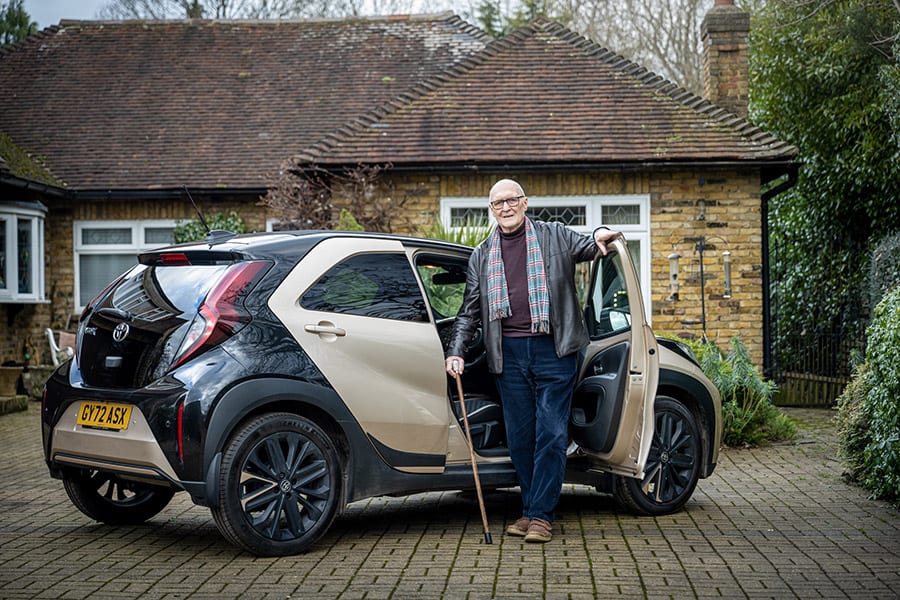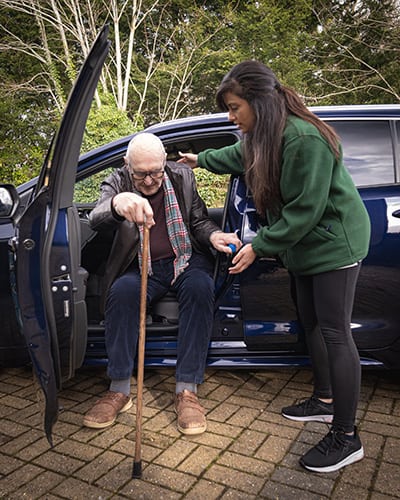Toyota and RCOT give tips on helping someone with mobility issues get into and out of a car

The helpful guidance can be used by health and social care professionals to pass on to their clients with reduced mobility who may struggle with getting in and out of a car.
Toyota teamed up with the Royal College of Occupational Therapists (RCOT) to put together the tips. They were published as part of Toyota’s mission to achieve better mobility for all.
Karin Orman, RCOT Director of Practice and Innovation, said: “If someone has mobility issues – perhaps an older person who is becoming frail or who has had a fall, or someone who has had recent surgery – getting into and out of a car can prove to be a challenge, making them reluctant to travel.
“Fortunately, there are lots of simple ideas and adjustments to help people of all ages and with a range of conditions, to overcome these difficulties. As occupational therapists we can provide advice to help you live your best life.”
Toyota spent a day with two occupational therapists (OTs), Natasha May Powell, an Advance Occupational Therapist Practitioner, and Charan Chana, a Senior Occupational Therapist with Central and North West London NHS Trust, alongside John Healy, from Virginia Water, who uses a walking stick, a walker, or a mobility scooter.
Natasha and Charan demonstrated ways of helping John to get into and out of two different size cars: a Toyota Aygo X and a Corolla Touring Sports.
Toyota and RCOT’s tips are detailed below.
Making adjustments
RCOT and Toyota’s first tip for people with restricted mobility is to make simple adjustments. They say that modern cars like the Toyota Aygo X and Corolla Touring Sports are simple to adjust to make access easier, safer, and more comfortable for passengers and drivers.
The organisations advise: “Move the seat back as far as it will go to create more space. This is particularly useful for people with knee issues or with prosthetic limbs.”
Another tip for people with reduced mobility is to adjust the seat belts so they are in the best position for comfort and safety. Drivers can also adjust the steering column to an optimum position.
Transporting equipment

For people using a boot, it is a good idea to put a blanket down first, the guidance says. This creates a smoother surface and makes it easier to slide equipment in and out.
Before the individual with reduced mobility gets into the car, their walking stick should be stored in the back, so that it does not interfere with the pedals.
Getting in and out of vehicles
RCOT and Toyota suggest that when getting into a car, the person should work out the safest place to put their hands to provide support. Instead of balancing on a walking frame, the individual could use the frame of the car or roof-mounted grab handles.
Alternatively, healthcare professionals can help their client get a portable door handle (sometimes known as a bunny handle). This provides a secure hand hold and, when not in use, fits neatly into the glove compartment or door pocket.
Individuals should get into a car bottom first. This ensures both feet stay on the floor until the person is sitting down, reducing the risk of a fall.
Once sitting down, the person can use a swivel cushion to help get into the right position. A plastic bag works well instead if the person does not have a swivel cushion, according to the advice.
Another tip from RCOT and Toyota is for the person to use a leg lifter to help get their legs over the sill of the car. Alternatively, a dressing gown cord or a yoga strap can work just as well.
The guidance cautions that cars of different heights can cause issues for people with reduced mobility. If a car is too high, a step could help. However, the step should be placed on a flat surfaced and weather conditions should be factored in. If a car is low, it should be parked on a flat surface. The advice states not to park by a kerb, as this will worsen the situation. Instead, the person should use the ‘bottom first’ technique.
Toyota and RCOT also urge individuals not to use a frame to get into and out of the car, as the surface may be unstable.
Parking
Charan comments: “When choosing a suitable parking spot, identify potential hazards to avoid difficulties when getting in or out of the car. Make sure there is enough room to open the door fully so that the driver and passenger can both get out easily, and safely retrieve any mobility aids.”
Parking on a level surface is important; uneven surfaces, like grass, can make getting in and out more difficult and potentially dangerous, the advice warns.

Preparing for long journeys
When the person is going on a long journey, thinking about how to break this down into more manageable chunks, for both the driver and the passenger, is helpful.
People should plan breaks to have a rest and rehydrate. This is particularly important for someone with a health condition where they become tired, according to the organisations.
After the demonstration, John said: “I will definitely be putting all the tips into practice, particularly the bunny handle and the dressing gown tie, which I wasn’t previously aware of. It’s removed some concerns about my mobility when leaving the house, giving me so much more freedom to carry on doing all the things I love, without being restricted to the house.”
Natasha concluded: “These simple and effective ways to access a car can completely change the life of you, or someone you are helping who has mobility issues. It increases independence and brings a new purpose and meaning into their life, which they may have lost due to concerns and anxieties about leaving the house.”

